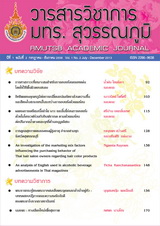An analysis of English used in alcoholic beverage advertisements in Thai magazines
Main Article Content
Abstract
This study was conducted to investigate what verbal and non-verbal techniques were used in English in alcoholic beverage advertisements published in Thai magazines. For Him magazine (FHM) was selected to participate in this study. In addition, the types of Thai cultural aspects appearing on alcoholic beverage advertisements in Thai magazines were also investigated.
Verbal techniques were analyzed using Cook’s foregrounding and Zakia’s intimate interaction techniques. In addition, non-verbal techniques were analyzed using Zakia’s Gestalt technique, figure and ground techniques, intimate interactions, eye leading techniques, signs, colors, camera shots, and composition.
Findings from the analysis of verbal techniques revealed that foregrounding and intimate interaction techniques played an important role in alcoholic advertisements in this study. In terms of foregrounding techniques, it indicated that wordplay was mainly used to construct the messages. Wordplay is a rhetorical device that often relies on different meanings of a polysemous word, the literal and non-literal meaning of an idiom, or on bringing two homonyms together in the same utterance to produce a witticism. In terms of intimate interaction, it showed that sentence types were used. These sentence types consisted of interrogative and imperative sentences. Interrogative and imperative sentences were frequently used in the advertisements to create face-to-face interaction.
As for non-verbal techniques, the findings indicated that color, figures, and ground techniques were mainly used to persuade the viewers. The color in alcoholic beverage advertisements is used to influence the viewers’ perception and evoke a particular feeling. In addition, figures and ground techniques are used to attract the viewers to the product, which is separated from the background. Moreover, the findings also revealed that the advertisers tried to persuade consumers through an indirect appeal such as changing negative aspects of the alcoholic beverage into positive ones.
In terms of Thai culture appearing in the advertisements, it was found that advertisers used indirect information to persuade consumers to buy their goods. It was also found that advertisers tried to make consumers feel that their products were a part of Thai culture.
Article Details
Published manuscript are the rights of their original owners and RMUTSB Academic Journal. The manuscript content belongs to the authors' idea, it is not the opinion of the journal's committee and not the responsibility of Rajamangala University of Technology Suvarnabhumi


